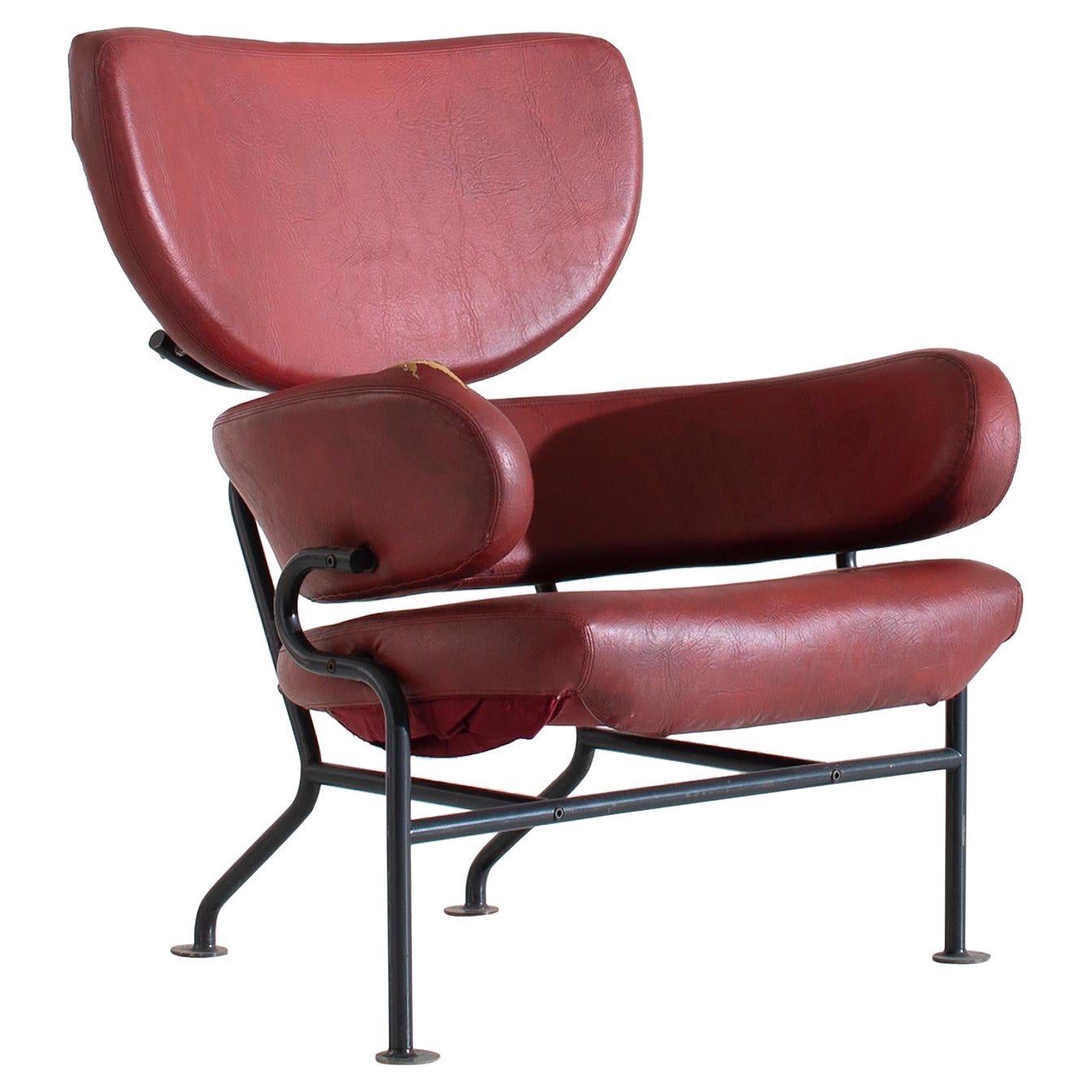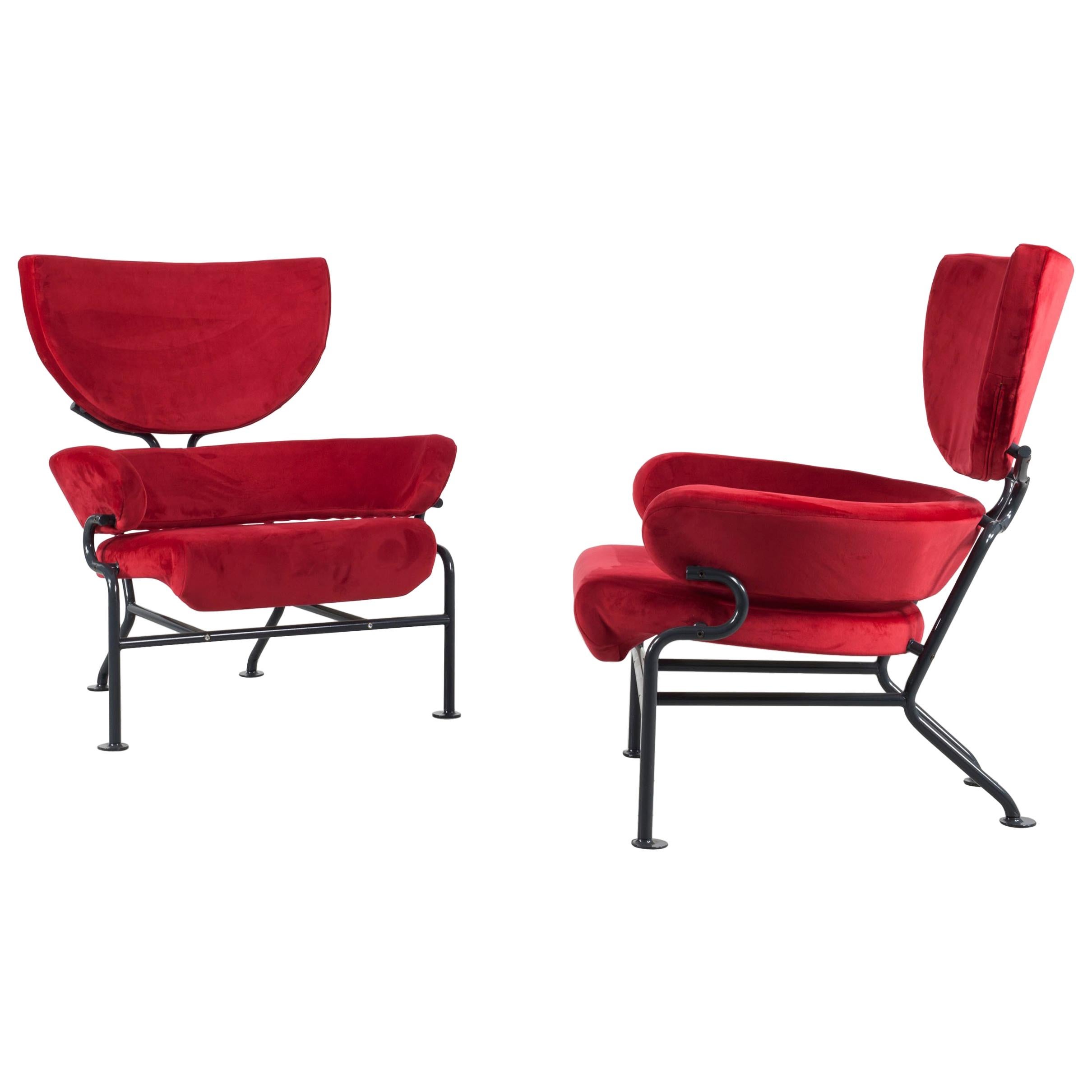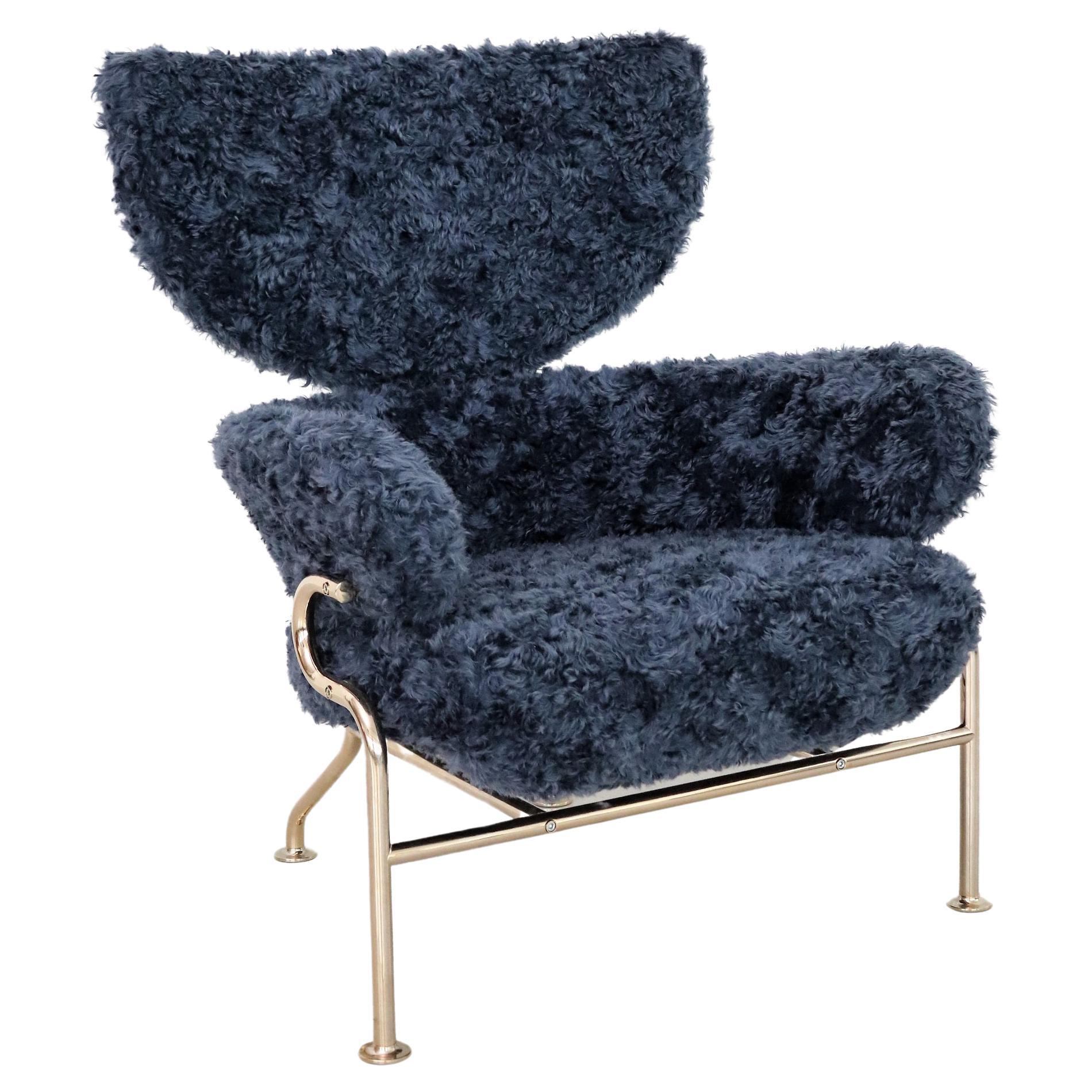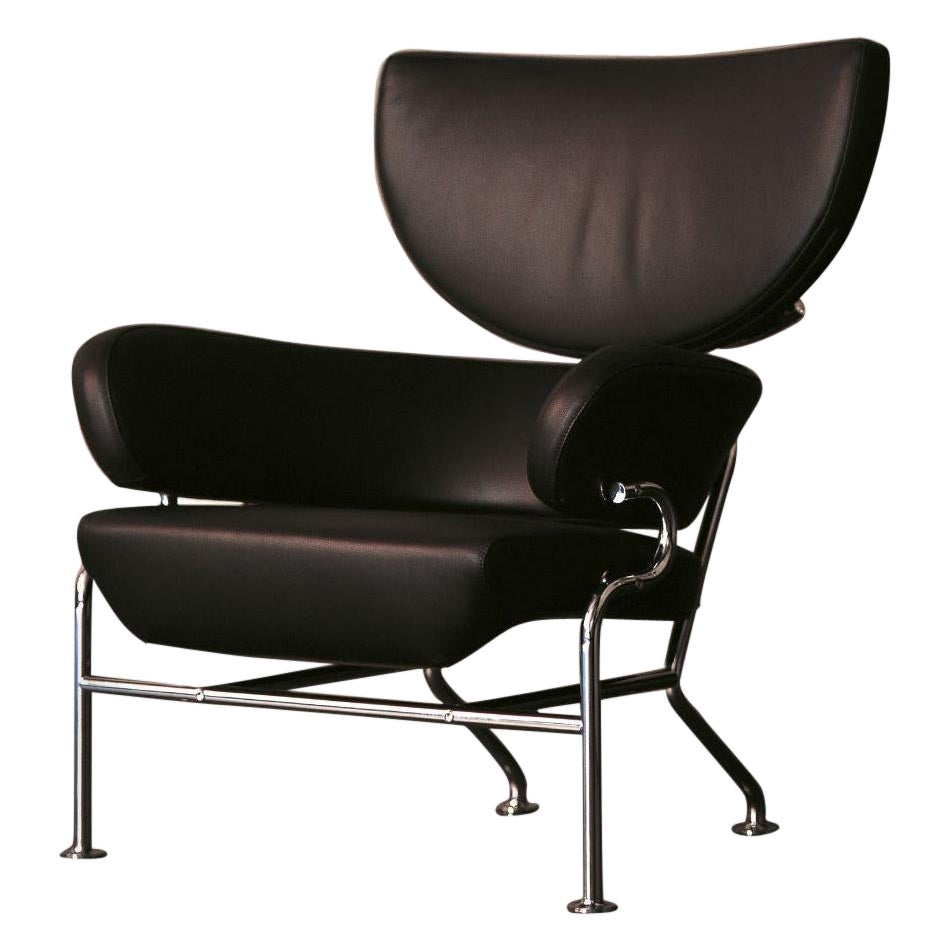Items Similar to Franco Albini PL19 or Tre Pezzi Armchair in Red Fabric by Poggi 1970s
Video Loading
Want more images or videos?
Request additional images or videos from the seller
1 of 11
Franco Albini PL19 or Tre Pezzi Armchair in Red Fabric by Poggi 1970s
About the Item
PL19 or Tre Pezzi armchair with frame in black lacquered tubular steel, seat and back in padded red fabric.
Designed by Franco Albini and Franca Helg in 1959 for the Nuove terme Luigi Zoja in Salsomaggiore, Italy, and produced by Poggi, Pavia between 1964-70.
The PL19 armchair was exhibited at the XII Triennale of Milan in the 1960.
After spending his childhood and part of his youth in Robbiate in Brianza, where he was born in 1905, Franco Albini moved with his family to Milan. Here he enrolled in the Faculty of Architecture of the Polytechnic and graduated in 1929. He starts his professional activity in the studio of Gio Ponti and Emilio Lancia, with whom he collaborates for three years. He probably had his first international contacts here
In those three years, the works carried out are admittedly of a twentieth-century imprint. It was the meeting with Edoardo Persico that marked a clear turning point towards rationalism and the rapprochement with the group of editors of “Casabella”.
The new phase that that meeting provoked starts with the opening of the first professional studio in via Panizza with Renato Camus and Giancarlo Palanti. The group of architects began to deal with public housing by participating in the competition for the Baracca neighborhood in San Siro in 1932 and then creating the Ifacp neighborhoods: Fabio Filzi (1936/38), Gabriele D’Annunzio and Ettore Ponti (1939).
Also in those years Albini worked on his first villa Pestarini.
But it is above all in the context of the exhibitions that the Milanese master experiments his compromise between that “rigor and poetic fantasy” coining the elements that will be a recurring theme in all the declinations of his work – architecture, interiors, design pieces . The opening in 1933 of the new headquarters of the Triennale in Milan, in the Palazzo dell’Arte, becomes an important opportunity to express the strong innovative character of rationalist thought, a gym in which to freely experiment with new materials and new solutions, but above all a “method”.
Together with Giancarlo Palanti, Albini on the occasion of the V Triennale di Milano sets up the steel structure house, for which he also designs the ‘furniture. At the subsequent Triennale of 1936, marked by the untimely death of Persico, together with a group of young designers gathered by Pagano in the previous edition of 1933, Franco Albini takes care of the preparation of the exhibition of the house, in which the furniture of three types of accommodation. The staging of Stanza per un uomo, at that same Triennale, allows us to understand the acute and ironic approach that is part of Albini, as a man and as a designer: the theme addressed is that of the existenzminimum and the reference of the project is to the fascist myth of the athletic and sporty man, but it is also a way to reflect on low-cost housing, the reduction of surfaces to a minimum and respect for the way of living.
In that same year Albini and Romano designed the Ancient Italian Goldsmith’s Exhibition: vertical uprights, simple linear rods, design the space. A theme, that of the “flagpole”, which seems to be the center of the evolution of his production and creative process. The concept is reworked over time, with the technique of decomposition and recomposition typical of Albinian planning: in the setting up of the Scipio Exhibition and of contemporary drawings (1941) the tapered flagpoles, on which the paintings and display cases are hung, are supported by a grid of steel cables; in the Vanzetti stand (1942) they take on the V shape; in the Olivetti store in Paris (1956) the uprights in polished mahogany support the shelves for displaying typewriters and calculators. The reflection on this theme arises from the desire to interpret the architectural space, to read it through the use of a grid, to introduce the third dimension, the vertical one, while maintaining a sense of lightness and transparency.
The flagpole is found, however, also in areas other than the exhibition ones. In the apartments he designed, it is used as a pivot on which the paintings can be suspended and rotated to allow different points of view, but at the same time as an element capable of dividing spaces. The Veliero bookcase, built in a single prototype in 1940, has two main uprights, made up of slender curved and juxtaposed bars, linked by a complex tensile structure. The lightened upright is also found in the LB7 bookcase, produced by Poggi in the 1950s.
Like the evolution of the upright, also the decomposition and recomposition of the architectural elements and the use of the module, constitute the elements of a method that tends to simplify the complex phenomena of design down to the essential nuclei.
Albini is a complete designer, whose work ranges from construction to design, from installations to urban planning. Among his masterpieces are: the Genoese Museums that change the way the public uses the work of art, the Pirovano Refuge in Cervinia, the Rinascente in Rome and the Milan Metro, which inspires the projects of the New York and Sao Paulo.
Silent, rigorous, ironic man, Albini works incessantly, supported by a moral code that accompanies him throughout his career. He firmly believes in the social role of the architect as a profession at the service of the people. He considers it the very reason for its existence.
- Creator:Poggi (Manufacturer),Franco Albini and Franca Helg (Designer)
- Dimensions:Height: 36.23 in (92 cm)Width: 33.08 in (84 cm)Depth: 28.35 in (72 cm)Seat Height: 16.15 in (41 cm)
- Style:Mid-Century Modern (Of the Period)
- Materials and Techniques:
- Place of Origin:
- Period:
- Date of Manufacture:1970s
- Condition:Wear consistent with age and use.
- Seller Location:Montecatini Terme, IT
- Reference Number:1stDibs: LU5304238995962
About the Seller
4.9
Gold Seller
These expertly vetted sellers are highly rated and consistently exceed customer expectations.
1stDibs seller since 2020
102 sales on 1stDibs
Typical response time: <1 hour
- ShippingRetrieving quote...Ships From: Borgo a Buggiano, Italy
- Return PolicyA return for this item may be initiated within 7 days of delivery.
More From This SellerView All
- Franco Albini PL19 or Tre Pezzi Armchair in White Wool by Poggi Pavia, 1950sBy Poggi, Franco Albini and Franca HelgLocated in Montecatini Terme, ITPL19 also known as Tre Pezzi armchair with black enameled steel tube structure, upholstered in white Mongolian goat wool. Designed by Franco Albini & Franca Helg for Poggi, Pavia...Category
Vintage 1950s Italian Post-Modern Armchairs
MaterialsSteel
- Franco Albini Cicognino Coffee Table in Teak Wood by Poggi Pavia 1970s ItalyBy Poggi, Franco AlbiniLocated in Montecatini Terme, ITCicognino coffee table entirely made in teak wood designed by Franco Albini in 1952 and firstly produced by the Italian company, Poggi Pavia from the 1950s. The Cicognino coffee t...Category
Vintage 1970s Italian Mid-Century Modern Coffee and Cocktail Tables
MaterialsTeak
- Franco Albini LB7 Bookcase in Teak Wood by Poggi Pavia 1950s ItalyBy Poggi, Franco AlbiniLocated in Montecatini Terme, ITLB7 bookcase composed of a single module with shelves and a storage unit with two doors, made in veneered solid teak wood, and black lacquered metal details. Designed by Franco Alb...Category
Vintage 1950s Italian Mid-Century Modern Bookcases
MaterialsMetal
- Franco Albini TL30 Round Table in Metal and Wood for Poggi Pavia 1950s ItalyBy Poggi, Franco AlbiniLocated in Montecatini Terme, ITRound table model TL30 with black lacquered metal base and a wooden top. Designed by Franco Albini for Poggi, Pavia in 1950s. After spending his childhood and part of his youth in Robbiate in Brianza, where he was born in 1905, Franco Albini moved with his family to Milan. Here he enrolled in the Faculty of Architecture of the Polytechnic and graduated in 1929. He starts his professional activity in the studio of Gio Ponti and Emilio Lancia, with whom he collaborates for three years. He probably had his first international contacts here In those three years, the works carried out are admittedly of a twentieth-century imprint. It was the meeting with Edoardo Persico that marked a clear turning point towards rationalism and the rapprochement with the group of editors of “Casabella”. The new phase that that meeting provoked starts with the opening of the first professional studio in via Panizza with Renato Camus and Giancarlo Palanti. The group of architects began to deal with public housing by participating in the competition for the Baracca neighborhood in San Siro in 1932 and then creating the Ifacp neighborhoods: Fabio Filzi (1936/38), Gabriele D’Annunzio and Ettore Ponti (1939). Also in those years Albini worked on his first villa Pestarini. But it is above all in the context of the exhibitions that the Milanese master experiments his compromise between that “rigor and poetic fantasy” coining the elements that will be a recurring theme in all the declinations of his work – architecture, interiors, design pieces . The opening in 1933 of the new headquarters of the Triennale in Milan, in the Palazzo dell’Arte, becomes an important opportunity to express the strong innovative character of rationalist thought, a gym in which to freely experiment with new materials and new solutions, but above all a “method”. Together with Giancarlo Palanti, Albini on the occasion of the V Triennale di Milano sets up the steel structure house, for which he also designs the ‘furniture. At the subsequent Triennale of 1936, marked by the untimely death of Persico, together with a group of young designers gathered by Pagano in the previous edition of 1933, Franco Albini takes care of the preparation of the exhibition of the house, in which the furniture of three types of accommodation. The staging of Stanza per un uomo, at that same Triennale, allows us to understand the acute and ironic approach that is part of Albini, as a man and as a designer: the theme addressed is that of the existenzminimum and the reference of the project is to the fascist myth of the athletic and sporty man, but it is also a way to reflect on low-cost housing, the reduction of surfaces to a minimum and respect for the way of living. In that same year Albini and Romano designed the Ancient Italian Goldsmith’s Exhibition: vertical uprights, simple linear rods, design the space. A theme, that of the “flagpole”, which seems to be the center of the evolution of his production and creative process. The concept is reworked over time, with the technique of decomposition and recomposition typical of Albinian planning: in the setting up of the Scipio Exhibition and of contemporary drawings (1941) the tapered flagpoles, on which the paintings and display cases are hung, are supported by a grid of steel cables; in the Vanzetti stand (1942) they take on the V shape; in the Olivetti store in Paris (1956) the uprights in polished mahogany support the shelves for displaying typewriters and calculators. The reflection on this theme arises from the desire to interpret the architectural space, to read it through the use of a grid, to introduce the third dimension, the vertical one, while maintaining a sense of lightness and transparency. The flagpole is found, however, also in areas other than the exhibition ones. In the apartments he designed, it is used as a pivot on which the paintings can be suspended and rotated to allow different points of view, but at the same time as an element capable of dividing spaces. The Veliero bookcase...Category
Vintage 1950s Italian Mid-Century Modern Dining Room Tables
MaterialsMetal
- Vico Magistretti Black CS49 Samarcanda Black Chest of Drawers by Poggi 1970sBy Poggi, Vico MagistrettiLocated in Montecatini Terme, ITChest of drawers model CS49 with four frontal drawers and four doors revealing inner shelves with structure in black lacquered wood and top upholstered with black skai or faux leather. Designed by Vico Magistretti and produced by Poggi in 1970s Ludovico Magistretti was born in Milan on 6 October 1920. He went to Parini High School and in autumn 1939 enrolled in the Faculty of Architecture at the Royal Polytechnic in Milan. After 8 September 1943, to avoid being deported to Germany, he left Italy during his military service and moved to Switzerland, where he took some academic courses at the Champ Universitaire Italien in Lausanne, taught at the local university. During his stay in the Swiss city he met Ernesto Nathan Rogers, the founder of the BBPR firm who had taken refuge in Switzerland after racist laws were passed in Italy. This was a key encounter in Magistretti’s intellectual and professional development, since the architect from Trieste turned out to be his maestro. He returned to Milan in 1945, where he graduated in Architecture at the Polytechnic on 2 August. He then immediately began his career working with the architect Paolo Chessa at the firm owned and run by his father, who died prematurely that same year. Here, in his father’s small firm, he spent his entire career in partnership with Franco Montella. During reconstruction operations in Milan from 1949-59, Magistretti designed and constructed about 14 projects for INA-Casa in conjunction with other architects. He was involved with Mario Tedeschi in the joint project for the QT8 neighbourhood, designing houses for veterans from the African campaign and also Santa Maria Nascente Church. In 1946 he participated in the R.I.M.A. exhibition (Italian Assembly for Furniture Exhibitions), held at the Palazzo dell’Arte, designing some small almost self-made pieces of furniture and then, in 1947 and 1948, he took part together with Castiglioni, Zanuso, Gardella, Albini and others in the exhibitions organized by Fede Cheti, a furniture fabric maker, held at her own workshop. The young architect was involved in plenty of activities and came up with lots of new ideas and proposals in the 1950s. Over the following years he also designed a number of other important projects, including the Towers in piazzale Aquileia (1961-64), Bassetti House in Azzate (1960-62), Cassina House in Carimate (1964-65), and the house in via Conservatorio in Milan (1963-66). In 1956 he was one of the founding members of the ADI, Industrial Design Association, and during the same year he was a member of the panel of judges for the Golden Compass Award for the first time. His work as an architect was almost totally focused on the issue of housing and living from the 1960s onwards, as he developed his own extremely expressive idiom, which, even though it was heavily criticised at times, made a real impression on the architectural scene in Lombardy during that period, making him one of its leading figures. This is the context in which he took part in the CIAM Congress (International Modern Architecture Congress) held in Otterlo in the Netherlands in 1959, during which the Italians presented Velasca Tower designed by the BBPR, the Olivetti canteen designed by Ignazio Gardella, Arosio house designed by Vico Magistretti (1956-59), and the houses in Matera designed by Giancarlo De Carli...Category
Vintage 1970s Italian Post-Modern Commodes and Chests of Drawers
MaterialsFaux Leather, Wood
- Studio 65 Bocca or Marilyn Sofa in Red Fabric by Gufram 1970sBy Gufram Furniture, Studio 65Located in Montecatini Terme, ITBocca or Marilyn sofa with structure in expanded polyurethane foam covered with red fabric, the cover is completely removable. This sofa was designed by Studio 65 and produced by Guf...Category
Vintage 1970s Italian Post-Modern Sofas
MaterialsFabric, Foam
You May Also Like
- Franco Albini PL19 Tre Pezzi Armchair for Poggi Pavia, Italy, 1960sBy Franco AlbiniLocated in Paris, FRArmchair designed by Franco Albini (1905-1977) and Franca Helg Model n° PL19, 'Tre pezzi' Lacquered metal, brass and recently eupholstered in white sheep wool skin. Early original m...Category
Mid-20th Century Italian Mid-Century Modern Armchairs
MaterialsMetal
- Franco Albini Armchair PL19 Tre Pezzi for Poggi Pavia Italy Circa 1959By Franco AlbiniLocated in Paris, FR"Model PL19" chairs or "The Pezzi" , designed by Franco Albini and Franca Helg, manufactured by Poggi Pavia, Italy. The chairs have a lacquered metal frame and are upholstered with ...Category
Mid-20th Century Italian Mid-Century Modern Armchairs
MaterialsMetal
- Franco Albini Set of Two "Model PL19", Manufactured by PoggiBy Franco Albini, PoggiLocated in Wolfurt, ATSet of two "Model PL19" chairs, designed by Franco Albini, manufactured by Poggi Pavia, Italy. The chairs have a lacquered metal frame and are upholstered with red velvet. Literat...Category
Vintage 1960s Italian Mid-Century Modern Armchairs
MaterialsMetal
- Tre Pezzi Special Edition Armchair by Franco Albini for CassinaBy Franco Albini and Franca Helg, CassinaLocated in Morazzone, VareseGorgeous iconic piece of design in a new interpretation of Limited Edition of only 100 pcs. Designed by Franco Albini together with Franca Helg in 1959, and manufactured by Cassina ...Category
2010s Italian Mid-Century Modern Armchairs
MaterialsMetal
- Franco Albini Tre Pezzi Armchair by CassinaBy Franco Albini, CassinaLocated in Barcelona, BarcelonaArmchair designed by Franco Albini in 1959. Relaunched in 2009. Manufactured by Cassina in Italy. In 1952, working with Franca Helg, his long-time assistant, Franco Albini designed Tre Pezzi...Category
2010s Italian Mid-Century Modern Armchairs
MaterialsMetal
- Franco Albini Tre Pezzi Armchair by CassinaBy Cassina, Franco AlbiniLocated in Barcelona, BarcelonaArmchair designed by Franco Albini in 1959. Relaunched in 2009. Manufactured by Cassina in Italy. In 1952, working with Franca Helg, his long-time assistant, Franco Albini design...Category
2010s Italian Mid-Century Modern Armchairs
MaterialsMetal





